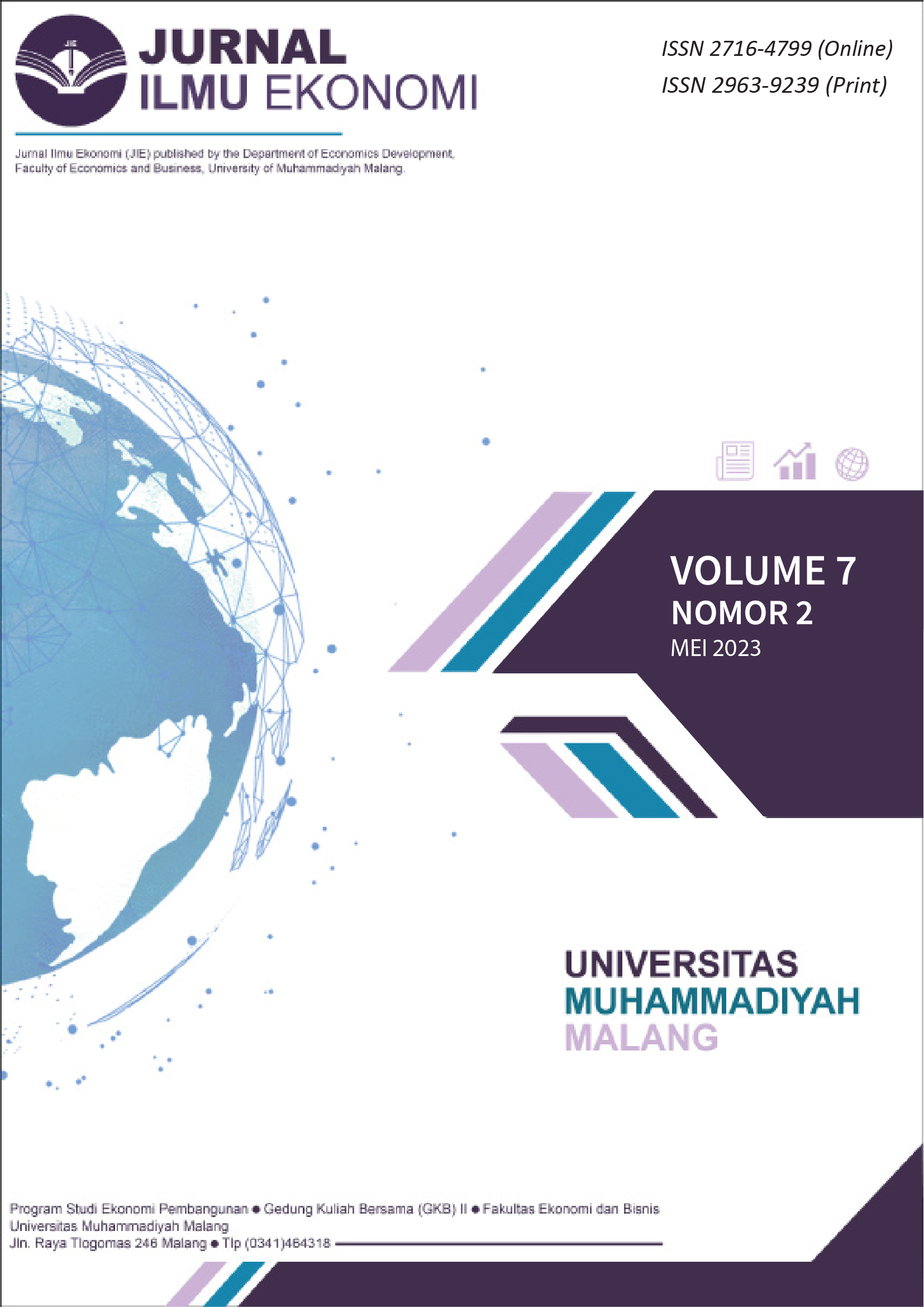Proyeksi Produksi Migas Indonesia Sampai Dengan Tahun 2045
DOI:
https://doi.org/10.22219/jie.v7i02.24654Keywords:
production, import, oil and gasAbstract
This study aims to determine how the influence of production on imports. The analytical tools used are trend analysis and simple linear regression analysis using time series data. The results of the study show that the projected oil and gas production fluctuates and tends to decrease every year, and the results of the production research whether it affects imports, the result is that the amount of production does affect the amount of imports and has a positive effect.
Downloads
References
Alhayat, A. P., & Muslim, A. (2016). Proyeksi Ekspor dan Impor Indonesia: Suatu Pendekatan Vector Autoregressive. Buletin Ilmiah Litbang Perdagangan, 10(1), 87–102. https://doi.org/10.30908/bilp.v10i1.32
Badaruddin, M. (2015). Indonesia Rejoining OPEC: Dynamics of the Oil Importer and Exporter Countries. JAS (Journal of ASEAN Studies), 3(2), 117–132. https://doi.org/10.21512/jas.v3i2.841
Dartanto, T. (2010). BBM, Kebijakan Energi, Subsidi, dan Kemiskinan di Indonesia. Persatuan Pelajar Indonesia, 5(3), 1–7.
Fauzi, F. (2016). Alasan Indonesia Keluar Dari Keanggotaan Opec Pada Tahun 2008-2016. Ekonomi, 4(2), 1–17. https://scholar.google.com/scholar?hl=id&as_sdt=0%2C5&q=indonesia+bergabung+dengan+opec&oq=indonesia+
Heyko, E. (2011). Strategi Pengembangan Energi Terbarukan (Bio-fuel) di Indonesia. Jurnal Ilmiah Mahasiswa FEB Universitas Brawijaya, 2(1), 2–15.
Kaukab, M. E. (2024). Latar Gelap Kampanye Politik 2023 : Krisis Ekonomi , Pangan , atau Energi ? Media Pengkajian Manajemen Dan Akuntansi, 21(2), 198–208. https://doi.org/10.32639/fokbis.v21i2.246
Kristina. (2021). Krisis Energi: Pengertian, Penyebab, dan Cara Mengatasinya. Detikedu, 1–2. https://www.detik.com/edu/detikpedia/d-5756087/krisis-energi-pengertian-penyebab-dan-cara-mengatasinya/1
Mawikere, J. C. (2008). Implikasi Kuota Produksi Minyak Organization of the Petroleum Exporting Countries ( OPEC ) dengan Kebijakan Keanggotaan dan Harga Bahan Bakar Minyak Pemerintah Indonesia Tahun 2008. Jurnal Analisis Hubungan Internasional, 5(3), 126–137. https://scholar.google.com/scholar?hl=id&as_sdt=0%2C5&q=indonesia+bagian+dari+opec&oq=in
Muchdar, M. I., & Fauzi, R. Al. (2013). Analisa Data Berkala Produksi Kayu Hutan dengan Metode Semi Average. TEKNIK INDUSTRI, 5(3), 1–13.
Rahayu, D. M., Supriyadi, I., & Yusgiantoro, P. (2018). the Strategy of Handling Crisis and Emergency of Oil Fuel With Scenario Planning. Ketahanan Energi, 4(1), 1–17. https://jurnalprodi.idu.ac.id/index.php/KE/article/view/258/238
Rakhmadi, H. A. (2020). Faktor-faktor Dibalik Keluarnya Indonesia dari OPEC (2016) [Universitas Katolik Parahyangan, Fakultas Ilmu Sosial dan Ilmu Politik]. https://repository.unpar.ac.id/handle/123456789/12799
Semedi, D. W., Radhi, F., & Dr., M. B. . (2019). Analisis Trend Produksi Minyak Bumi (Study Pada Perusahaan Pt. Pertamina Hulu Energi West Madura Offshore) [Universitas Gadjah Mada, Magister Manajemen]. http://etd.repository.ugm.ac.id/penelitian/detail/173928#filepdf
Umar, A. R. M. (2012). Analisis Kebijakan Liberalisasi Sektor Hulu Migas Indonesia pasca-1998. Jurnal Ilmu Sosial Dan Ilmu Politik, 16(1), 45–61. https://journal.ugm.ac.id/jsp/article/view/10911
Veno, A. (2015). Analisis Trend Kinerja Keuangan Perbankan Syariah Tahun 2015 Sampai Dengan 2017. Bisnis Dan Manajemen Islam, 4(1), 22–34. https://journal.iainkudus.ac.id/index.php/Bisnis/article/download/1694/1506
Yuliara, I. M. (2016). Modul Regresi Linier Sederhana. Universitas Udayana, Fakultas Matematika Dan Ilmu Pengetahuan Alam, 3(1), 1–10. https://simdos.unud.ac.id/uploads/file_pendidikan_1_dir/3218126438990fa0771ddb555f70be42.pdf
Downloads
Published
How to Cite
Issue
Section
License
Copyright (c) 2023 Dewanto, M. E.

This work is licensed under a Creative Commons Attribution-NonCommercial-ShareAlike 4.0 International License.
Authors who publish with this journal agree to the following terms:
- For all articles published in the JIE (Jurnal Ilmu Ekonomi), copyright is retained by the authors. Authors give permission to the publisher to announce the work with conditions. When the manuscript is accepted for publication, the authors agree to the automatic transfer of non-exclusive publishing rights to the publisher.
- Authors retain copyright and grant the journal right of first publication with the work simultaneously licensed under a Creative Commons Attribution-NonCommercial-ShareAlike 4.0 International License that allows others to share the work with an acknowledgement of the work's authorship and initial publication in this journal.
- Authors are able to enter into separate, additional contractual arrangements for the non-exclusive distribution of the journal's published version of the work (e.g., post it to an institutional repository or publish it in a book), with an acknowledgement of its initial publication in this journal.
- Authors are permitted and encouraged to post their work online (e.g., in institutional repositories or on their website) prior to and during the submission process, as it can lead to productive exchanges, as well as earlier and greater citation of published work (See The Effect of Open Access).
This is an open access article and licensed under a Creative Commons Attribution-NonCommercial-ShareAlike 4.0 International License








